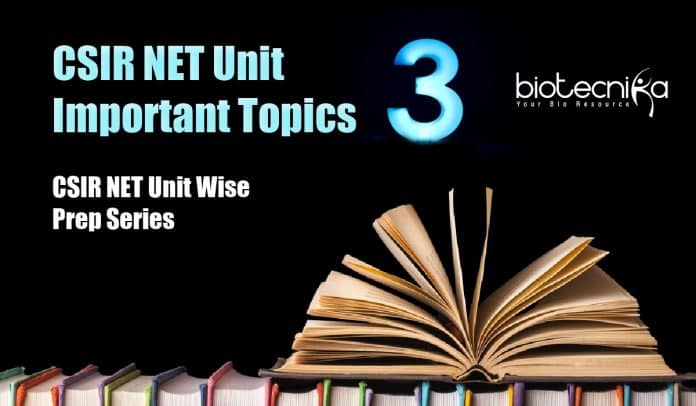CSIR Unit 3 Preparation – How to Study Unit 3 For The CSIR NET Exam?
CSIR NET Life Sciences Unit 3 Important Topics & Preparation
If you are aspiring to get enrolled in Ph.D. or dreaming around to teach in the renowned colleges or universities then you must undertake the most prestigious and recognized national level exam, the CSIR NET, offering JRF and Eligibility for Lectureship in India.
CSIR is a tough nut to crack indeed, requiring an honest, sincere, dedicated, and onerous input from the aspirant while projecting a smart strategy to work. Nevertheless, you must believe “The most successful people work smart, not hard”
To stand out among the crowd and to earn good rewards, the foremost necessity is to come up with a study plan which can help you to get closer to your goals.
The crux of the matter is to design a blueprint about, which units you must consider, and which topics must be emphasized on and to what depth or extent.
While initiating preparations for any exam it is essential to figure out all the important topics from the CSIR syllabus, having maximum weightage determined by doing the research analysis of the previous year examination papers
. This enhances & boosts the potential for an aspirant.CSIR Life Sciences syllabus is huge and practically you need to nail down the important units if not all the 13 units included.
CSIR Unit 3 Preparation
Among these, Unit 3 – ‘Fundamental Processes’ is one such nontrivial unit which can enable you to fetch a good score in the exam. The expected percentage of questions from unit 3 is persuasive where 12% questions can be asked in Part B and 8% questions can be asked for Part C. This unit includes the molecular biology topics and cherishes to be among the top choices of the aspirants.
Let’s Have a Glance at the Syllabus for CSIR Unit 3 – Fundamental Processes
- DNA replication, repair, and recombination: Unit of replication, enzymes involved, replication origin and replication fork, the fidelity of replication, extrachromosomal replicons, DNA damage and repair mechanisms, homologous and site-specific recombination.
- RNA synthesis and processing: Transcription factors and machinery, the formation of initiation complex, transcription activator and repressor, RNA polymerases, capping, elongation, and termination, RNA processing, RNA editing, splicing, and polyadenylation, structure, and function of different types of RNA, RNA transport.
- Protein synthesis and processing: Ribosome, the formation of initiation complex, initiation factors and their regulation, elongation and elongation factors, termination, genetic code, aminoacylation of tRNA, tRNA-identity, aminoacyl tRNA synthetase, and translational proof-reading, translational inhibitors, Post-translational modification of proteins.
- Control of gene expression at transcription and translation level: regulating the expression of phages, viruses, prokaryotic and eukaryotic genes, the role of chromatin in gene expression, and gene silencing.
Check CSIR NET UNIT 3 Smart Preparation Tools
Why Should One Consider CSIR Unit 3 as part of the Preparation Approach?
The promising aspect of conquering this unescapable unit which might give you another reason to persuade this unit is that you can expect almost straight, undeviating, and subject-specific questions which is like getting a blessing in disguise. This unit is not only significant from the examination point of view but also paves the way to understand the fundamental mechanisms going at the cellular level which forms the foundations to grab concepts included in other units.
Let us Elicit with Seizing the Most Elemental Subtopic.
- “DNA replication” A term which might appear so familiar that needs no inception, but have you ever thought intensely; why is this process so crucial to the cell?
- Besides other essential aspects like how, where, and when this process occurs? What are the components involved in the replication? you must hunt for answers to all these factual questions primarily.
- Why does a cell need to divide? Cells divide to accede an organism’s growth, assist replacement of dead and worn cells, and to perform the most salient process of the life ‘the reproduction’. DNA replication can be considered as the basis of biological inheritance in all living beings, without it the daughter cells formed during mitotic and meiotic events will be devoid of the genetic information. So you may expect questions relating the concepts of the cell cycle from Unit 2 to Replication from Unit 3.
- The components of the replication machinery are various enzymes with DNA Polymerase as the core enzyme, the others being mainly helicase, topoisomerase, single-strand binding proteins, primase, DNA ligases, and nucleases.
- Part B questions are commonly asked on the basic functions of the replisome enzymes and the effect and consequences of mutations on them.
Semi-conservative model of DNA replication, the foundation:
- The semiconservative model given by Watson and Crick, further supported by Meselson and Stahl experiment suggests that each new DNA molecule formed during replication would be a hybrid structure with one old and one new strand.
- Be prepared to conquer all the aspects related to this experiment because questions based on the pattern of inheritance of heavy and light DNA strands with and without heavier isotopes of nitrogen, respectively are often asked in Part C.
- The other proposed mechanisms like conservative and dispersive should also be covered as hypothetical and experiment-based questions could be expected in Part C from these mechanisms.
Replication at lagging strand:
- You must have a complete vision about the conviction supporting leading and lagging strand during DNA replication, how copying at lagging strand is different from the leading strand, and how the primers are involved for these two?
- You may expect direct questions in Part B based on the origin of replication Ori sites in prokaryotes and eukaryotes, Okazaki fragments, and in Part C questions framed on bidirectional forks and components involved.
- Part B questions are often asked from DNA polymerase types, Klenow fragment, detailed structure for DNA polymerase III holoenzymes.
Telomerase, the unique enzyme, and discovering its relation to cancer:
- Many cells especially the germ cell have a distinctive enzyme known as telomerase compensating for the loss of sequences at the chromosomes ends but importantly this enzyme turns overactive in the cancer cells imparting immortality to these cells. You may expect questions linking the telomerase to the cancer concept from unit 4 too.
- A crisp review of Extrachromosomal replicons and their replication mechanisms like theta mode of replication, rolling circle, and strand displacement mechanisms must be given.
A proofreading and repair machinery to prevent erroneous activity:
- Many inadequacies may occur during cellular events because of mutations, radiations, or some chemicals which replace the original nucleotides.
- All types of mutations, sources of mutations, base analogs, base modifying agents, intercalating agents, oxidative radicals, UV radiations resulting in DNA damage are important to be covered not only to get a hold on the impacts these agents could have on DNA but also attain a perspective of the DNA repair mechanisms which turn on to check on these defects.
- Make a colorful chart enlisting the names of the common and uncommon mutagens with the corresponding effects they could have on the genetic construction.
- You may expect both Part B and Part C diagram based questions asked on the type of mutations and mutagens.
- Make a flowchart with types of mutations, you will extract double benefit out of it as mutation study is also included in unit 8, ‘Inheritance biology’.
Repair mechanisms, types, and components:
- Direct damage reversal methods involving only a single protein like photolyase and methyltransferase are the most energy-efficient and restore a few basic types of DNA damage.
- Single strand repair mechanisms have a lesser probability of incorporating errors in comparison to double-strand break repair mechanisms. Base excision repair, nucleotide excision repair, mismatch repair, non-homologous end joining, homology-directed repair, microhomology-mediated end joining, must be thoroughly understood along with the names of all the proteins and enzymes included.
- The good part about fetching on these repair mechanisms is that you may easily score indirect questions asked in Part B and little analysis and interpretation can enable you in cracking Part C questions too
- One of the important topics is about translesion polymerases, how they possess a unique mechanism of evading the presence of lesions, and how the polymerase switching is facilitated, this all must be grabbed comprehensively.
- SOS repair revolving around LexA repressor proteins is another concept to be learned and prepared.
Transcription, the passage of information:
- Within this topic, every detail about the transcription initiation, elongation, and termination in both prokaryotes and eukaryotes must be nailed down.
- Different forms of RNA, their functions in the cell, RNA polymerase structural components in prokaryotes and eukaryotes, the concept of abortive initiation and promoter escape, initiation complex formation, intrinsic and extrinsic termination in prokaryotes, CTD phosphorylation in RNA Polymerase, and its role in eukaryotic transcription initiation, elongation, and termination, specifics of core promoters and regulatory sequences, general transcription factors in eukaryotes with their roles, activators and coactivators, torpedo and allosteric models for transcription termination in eukaryotes are the concepts to be gripped over.
Check CSIR NET UNIT 3 Smart Preparation Tools
Post-transcriptional processing of RNA in eukaryotes:
- One has to accentuate on topics like Cap formation on 5’ end and its significance, capping enzymes, 3’ polyadenylation and its alliance with transcription termination, Self-splicing and spliceosome mediated RNA splicing mechanisms, variants of splicing, defects associated with splicing.
- Don’t miss on RNA editing. It contains its own exclusive procedures like incidences of site-specific deamination and action of guide RNA resulting in the synthesis of a variety of tissue-specific protein products. It becomes even more important to be understood in relation to the most happening CRISPR technology.
- Questions are asked in both Part B and Part C from this subunit and thus it constitutes one of the important topics to be prepared.
Proteins, the key molecular “building blocks” are synthesized through translation:
- The proteins need well-entrenched protein-synthesizing machinery which is quite bulky and complex consisting of mRNA, ribosomes, t RNA, aminoacyl synthetase enzyme, and various other initiation factors that are distinct in prokaryotes and eukaryotes.
- Before instigating the nitty-gritty of the translation, it is extremely crucial to perceive intact ideas about the central dogma of molecular biology, genetic code, and its properties. The ‘Wobble hypothesis’ concept is inevitable.
- An intricate study is mandatory over the initiation, elongation, translocation, release, and the regulatory factors involved, along with the specific tasks they perform during each translation cycle in prokaryotes and eukaryotes. Statement based Part C questions is asked from this subtopic.
- ‘Antibiotics’, how and where they exactly interfere with the translation events, making them a powerful tool against the treatment of bacterial diseases must be understood as part of this subtopic. This is extremely important in reference to Part B questions.
- Post-translational modifications that involve key mechanisms to regulate activity, localization, and interactions of proteins with other cellular molecules must also be emphasized during preparation. This topic can be commonly prepared with ‘organelle-specific Protein trafficking’ from Unit 2B
Regulation is an essential aspect of all biological processes:
- Control of gene expression is the utmost requisite both in prokaryotes and eukaryotes however it may employ a distinctive set of components in both.
- The Operon system presents an appropriate example of gene regulation in bacteria and certain viruses. Lac operon, trp operon, arabinose operon, and switching of the lytic cycle over the lysogenic cycle in viruses are the key topics to be annihilated from this subunit.
- Numerical based questions from Lac operon and theory-based questions from all the operon systems are often asked from this subtopic in Part C.
- In eukaryotes, regulation is performed by adopting a different approach where chromatin remodeling is the dynamic mechanism controlling the access of condensed genomic DNA to the transcriptional machinery. So the factors affecting the chromatin organization must be learned thoroughly.
Do’s and Don’ts During CSIR Unit 3 Preparation
- Make descriptive and colorful charts displaying the names of various factors involved in replication, transcription, translation, and other proteins which are part of the regulatory mechanisms including inhibitory proteins and antibiotics.
- Do not recede from covering any subtopic because questions are usually constructed to have a combination of statements that may be sourced from different subunits.
- Ensure that you learn and conquer recombinant DNA technology techniques from unit 13 ‘Methods in biology’ and mutational concepts from Unit 8 ‘Inheritance biology’ to have a coherent grasp over the questions constructed in an amalgamated manner.
- Do practice numerical type questions from lac operon to have a deep insight into the concept.
Refer to good standard books like:
- Molecular Biology of the Gene by ‘James D. Watson’,
- Lehninger Principles of Biochemistry by ‘David L. Nelson and Michael M. Cox’,
- Molecular Cell Biology by ‘Harvey Lodish, Arnold Berk, Chris A. Kaiser’, and
- Cell and Molecular Biology: Concepts and Experiments by ‘Gerald Karp’
There are countless guides and books available which might proclaim to guarantee you success, but success is entirely personal and unique to everyone. You at best carry the potential to lay ‘CSIR’ as the stepping stone to your career, by designing an eccentric approach. Follow this CSIR Unit 3 Preparation Tips, and for more tips on CSIR NET Unit 1 and Unit 2, check out the CSIR NET Unit Wise Prep Series at BioTecNika’s Career Advice Section.
Go ahead and be victorious with the following thought to inspire you with:
“The path to success is to take massive but determined actions.”
Read Also:







































Very useful for CSIR net preperation